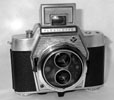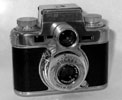
Click towards the left edge of the thumbnails to see a normal B&W photo, or click towards the right edge to see a stereo B&W photo. To view the stereo images, look through a red filter with your left eye and a green or blue filter with your right eye.

Agfa Flexilette, a 35mm twin-lens reflex manufactured in the early 1960s.
This example is missing a dull-chrome plate that should surround the two lenses,
but it works fine.

Ansco Automatic Reflex. An attempt by Ansco to manufacture a genuinely world-class
high-quality TLR in the USA in the late 1940s/early 1950s. It is a large, heavy,
camera with a quality feel and some unusual features, such as the focusing wheels
visible on either side of the lens housing, and the shutter release and cocking
levers between the lenses. Apparently, it was overpriced for its intended market.

Bolsey C, a 35mm twin-lens reflex with coupled rangefinder and optical
viewfinder, just for the sake of redundancy. This camera works, but is missing
the red B from the finder lid.

Ciroflex E. Made in the USA by Ciro Cameras, Inc, before they were bought out
by Graflex. Formed the basis for the Graflex 22 (see below). Not bad quality
but a bit rough around the edges and had only a three-element lens.

Graflex 22. Made by Graflex, Inc. in the 1950s after their buyout of Ciro.
A competent but far from flashy camera. The model finished in gray leather is
rather nice looking. Some parts also appear to be in polished stainless steel,
unusual for camera parts.

Mamiyaflex I, the original model from 1951 with no self-timer or sportsfinder.
6 X 6 images on 120 rollfilm. Precursor of the very successful C series Mamiya
TLRs, but very different, with gear-coupled focusing and non-interchangable lenses.

Minolta Autocord. Late 1950s model with Rokkor lenses, no light meter. A high-quality TLR considered by many to be about equal to Rollei

Rolleiflex Automat. Made by Franke and Heideke between 1939-49. This camera
has clearly had a lot of use, quite possibly by a press or wedding photographer.
It has been fitted with a solenoid shutter release, which would have been triggered
by a large external flashgun as often seen on Speed Graphic-style press cameras.

Rolleicord III. Early 1950s. Coated Xenar 75/3.5 lens in x-synchyed Compur
Rapid shutter. Capable of very nice picture taking, but the lack of a Fresnel
lens means dim images on the groundglass.

YashicaFlex. Early 1950s predecessor of the later Yashicamat series. Uncoupled
built-in Sekonic exposure meter, Yashinon 4-element coated lens.

YashicaMat. Late 1950s, predecessor of the still-popular YashicaMat 124G, which
adds a coupled CdS meter but is otherwise very similar. A nicely made camera
with a very good coated 4-element Yashinon lens and Fresnel groundglass.

YashicaMat LM. More or less identical to the YashicaMat, but with a built-in
uncoupled selenium light meter. Still a good picture taker, but the meters tend
to be unreliable.

Zeiss Ikon Ikoflex Ia. Early 1950s. This camera is equipped with the coated Zeiss Opton Tessar 75/3.5 taking lens and is capable of taking very nice pictures, despite being near the bottom of the Ikoflex line. This particular camera is in near-mint condition and was professionally CLAed recently, so it works very nicely.
All images and text on this site are copyrighted by Ross A. Alford and may not be reproduced without permission